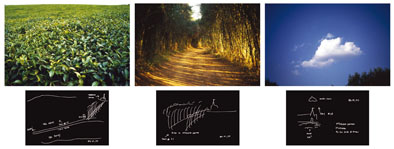Alfredo JAAR
field road and cloud
DIMENSIONS: 61 x 92 cm / 15 x 22,5 cm
TECHNICAL: photography / red on paper

Field Road and Cloud, 1997 Field, Road, Cloud consist of three large framed photographs, each paired with a small reproduction of a sketch indicating their location. The first large photograph pictures a lush green field of tea, stretching out to the horizon. In the far distance to the left stands a white building with a broad brown roof. The sketch next to the photograph indicates that it was taken on the main road from Kigali on August 29, 1994. We recall that the main export crops of Rwanda are tea and coffee, and that the farm land is rich and productive. The next photograph is especially gorgeous. A rough dirt road is bathed in late afternoon or early morning golden sunlight. The trees lining the road cast striated shadows across it. In the top center of the image appears a torso-shaped patch of sky. Glancing at the sketch next to the image, we read that this the road to Ntarama Church. In the last photograph in the series, one cottony white cloud i s framed by a deep blue sky. The could has begun to break up, letting off a few fine wisps. In the last sketch, the “lonely could” appears directly above the pointed steeple and cross of Ntarama Church. In front of the church are drawn some squiggly lines and under them the legend, “BODIES, 500?” This is the church where Gutete Emerita saw her family killed. There images on the way to a killing site: fecundity, felicitous light, and freedom of movement. I remember once travelling on a train form East to West Germany before the Wall come down, and looking out the window at a row of trees, and wondering whether this was an East German or a West German row of trees. The Rwandans have insisted on leaving some of the killing sites, like Ntarama Church, as they are, with dead bodies all around, so that people can see with their own eyes what happened. But the truth is, human bodies do not make good monuments. They decompose quickly and disappear. There will have to be other ways to show the world what happened. David Levi Strauss from A Sea of Griefs is not a Proscenium ACTAR, Barcelona, 1998
Exhibitions
April - May 2011- essential art.





